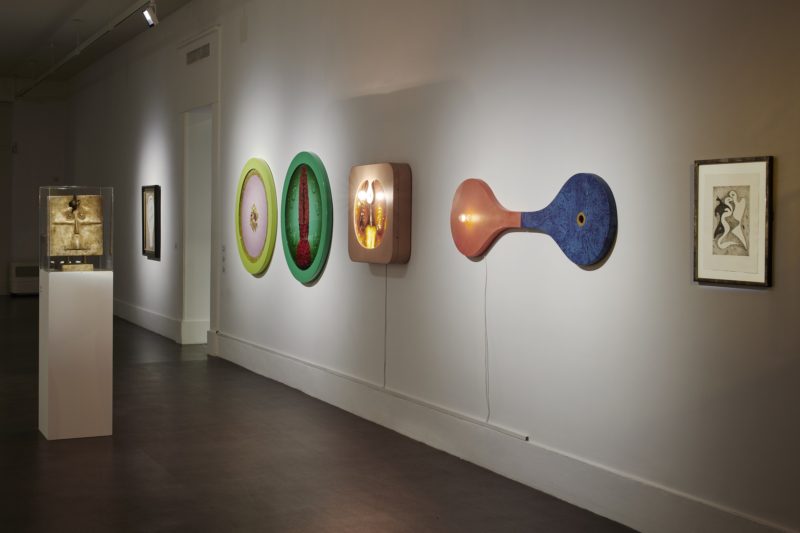
Any brief, cursory inquiry into the canon of art in the last two centuries has revealed that desire – an overwhelming passion or wish for something or someone – is not only a universally experienced emotion, but redolent of powerful identification for the viewer.
Taken collectively, desire is at the very crux of the autumn exhibition of works at the Irish Museum of Modern Art (IMMA). Exploring the evolving and unremitting sensation of desire as it manifests in power structures or through individual relationships, Desire: a Revision from the 20th Century to the Digital Age endeavours to reconsider the experience of desire from the Eurocentric male gaze, encompassing a much more varied approach.
If desire is defined as a longing for something, or a craving for more, this exhibition certainly contradicts its theme – it is a veritable visual bounty of over 100 artworks, including painting, sculpture, installation, video, photography and performance. The multidisciplinary nature of the exhibition’s conception is dizzying. By incorporating masterworks from eminent Surrealist painters from the 20th century alongside contemporary works, the exhibition is an astounding spectacle of how much yearning has advanced.
The layout of the works in the gallery is superb, and the contents of the exhibition seem to unfurl as the viewer progresses through the space – indicative of the show’s thematic crux, an unfolding and disrobing of its contents until one is exposed in front of the work before them.
The initial entrance to the exhibition’s space is almost a circumvention of explicit explanation. The Surrealist perspectives of desire are much less perspicuous than those of the more contemporary works that accompany them – such as Rene Magritte’s “Le Mirior Magique”, which is emblazoned with the words “corps humain”, explicating the mirror as a device for mystery and desire. Also displayed here are excerpts from James Joyce’s infamous and controversial private letters to Nora Barnacle. The letters offer a deeply personal, borderline repulsive insight to their sexual relationship. Joyce seems to be writing in the throes of some overwhelming passion.
The collection contains works ranging from bullion Bronze Age treasures and gold engravings to more futuristic approaches to sculpture and photography. The exhibition’s mission to elucidate a more nuanced and diverse depiction of desire is manifest in Bharti Kher’s “Blind Matter”, a striking and monumental Bindi painting. Mickalene Thomas’ paintings, which draw inspiration from traditional methodology of Western portraiture, create incredibly evocative portraits of assured women. His work acts as a jubilant celebration of black femininity pieced together from elements of iconography in art history and pop culture.
Immersion and exploration are paramount in Desire: A Revision, with disquieting predictions of our impending future detailed in the various video installations and interactive video games featured. Perhaps the most impactful of these is Elaine Hoey’s “Running Man”, in which the dialectics between player and game are stripped back to merely the landscape and a startlingly naked avatar. Frustrations arise when our desires are unfulfillable through the mechanics of the game.
The absurd and the uncanny are relished in the exhibition. The works of Irish artist Genieve Figgis are perhaps the most stirring additions to the collection. By constructing an immersive space reminiscent of the pomp and pageantry of a stately home – complete with four-poster bed and gold-filigree chaise lounge – Figgis creates paintings that are mimetic of Rococo and bourgeois portraits.
The ostentatious costumes of the ladies along with their grisly facial expressions are distinctly dystopian. Paint is at Figgis’ complete command, as she heightens the caricatural effects of her figures and parodies the Old Masters through her slathering of sumptuous paints and bold strokes. As is elementary to the oeuvre of Tracey Emin, human relationships are explored in her works selected for display in a personal and alluring manner, acting as a sort of intimate epiphany, which is an absolute joy to behold.
The exhibition’s use of the space is symbolic of its theme – it toys with the process of unveiling that is so bound to feelings of desire. Truly a cornucopia for the senses, and a visual triumph, I would recommend leaving yourself a few full hours to plunge into the depths explored in this exhibition. Admission is free for students, and the exhibition runs until March 22nd.






